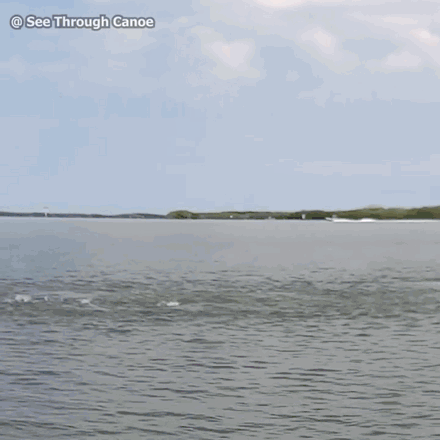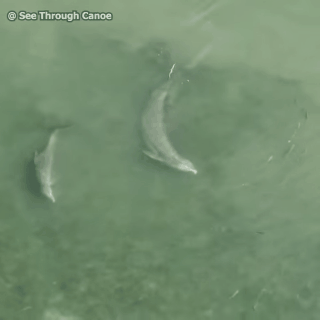Watch Dolphins Punt, Thrash and Trap Their Prey
Recent observations showcase dolphins’ diverse—and often violent—hunting techniques
/https://tf-cmsv2-smithsonianmag-media.s3.amazonaws.com/filer/26/d1/26d1d362-a563-4157-ab44-8fda813fe9c6/gettyimages-479572113.jpg)
In a video uploaded to YouTube this summer, a dolphin slowly churns the water as it herds a school of fish. Then, in one fluid sweep, its tail whips through the water. Audio from a baseball game is layered onto the video, and the crack of a bat plays as the dolphin’s powerful tail whips against the fish’s side. The unsuspecting prey makes a clean arch before splashing back into the water where it floats, stunned, until the dolphin scoops it up. The invisible crowd goes wild.
The video was captured by Michael McCarthy, an amateur videographer and owner of the company SeeThroughCanoe. The feeding method used by these dolphins is technically called “fish-kicking” or “fish-whacking” and according to McCarthy’s commentary, dolphins like the one in his video can make a successful catch in about 70 percent of their attempts.

Fish-whacking has been observed in several groups of bottlenose dolphins outside Florida, including the U.S. Gulf Coast and New Zealand, Stefanie Gazda, a biologist at the University of Florida tells Douglas Main at National Geographic. Dolphins that specialize in techniques like fish-kicking have an edge over dolphins that rely on group hunting. The individual dolphin that bats the fish away from the group may not be a team player, but it secures a delicious meal all to itself.
“This helps reduce competition between individuals, and gives the [fish-kickers] an advantage over those doing the same thing as everybody else,” Shannon Gowans, a behavioral ecologist at Eckerd College in St. Petersburg, tells National Geographic.
Dolphins mostly feast on fish like cod and mackerel or invertebrates like squid and other cephalopods. Though they have teeth, dolphins tend to swallow their prey whole, digesting it in several stomachs. To make their food easier to consume, they sometimes shake it or slam it on the water’s surface to dismember it. The slamming method is especially important when eating octopuses, as some dolphins off the coast of West Australia and elsewhere do.
Octopuses pose a particular danger to dolphins. Their powerful suckers allow them to attach themselves to dolphins, even after the octopus has died. Sometimes their tentacles cover the dolphin’s blowhole or fill their throats, suffocating the dolphin. By battering the octopuses, dolphins render their arms unresponsive and ready to eat.

Individual techniques like fish-whacking and octopus-dismemberment are rarely observed. Most commonly, dolphins work together to herd or corral their prey. Some cetacean pods round up fish into “bait balls” and take turns plowing through the fish cluster, snatching their disoriented prey. This method is best suited for dolphins living in the open ocean while those in different environments have developed unique techniques.
For example, bottlenose dolphins living in rivers, estuaries and other shallow bodies of water similarly work in teams to drive fish them toward the shore. Once the prey is gathered, the dolphins propel themselves up the river bank, using the force of their bodies and the rush of water to push the fish up with them. The muddy banks serve as barriers to guide the fish into their open mouths.
To keep the fish from escaping between them, the dolphins always beach themselves on the right side. Each time they attempt this, the dolphins risk driving too hard and beaching themselves permanently. Over time, the mud they intake with each mouthful of fish wears down the teeth on their right side. As they age, they are often forced to turn toward other hunting methods.
Other shallow water-dwelling dolphins use mud to their advantage. Gazda studies this behavior among bottlenose dolphins in Florida. Working in teams or independently, they circle a group of fish, dragging their tail along the sea floor to stir up sediment. The plume limits the fishes’ visibility, causing them to panic and leap out of the way and into the mouths of waiting dolphins.
Being such remarkably social creatures, dolphins have been known to fish alongside humans as well. Fishermen in Myanmar have likely cooperated with Irrawaddy dolphins for centuries, reports Doug Clark of the New York Times. The dolphins herd fish, directing fishermen where to cast their nets. Though humans gain the majority of the catch, dolphins snag stragglers or nab loose fish from the edge of the net.
Like a fisherman uses a pole or net, some dolphins also use tools to fish. In Shark Bay off the west coast of Australia, female dolphins hold sponges in their mouths to protect their beaks from urchins, stingrays and sharp objects while fishing in rocky areas, writes The Atlantic’s Megan Garber. Though first documented 180 years ago, researchers have only recently begun to understand these dolphins’ tool usage. According to a 2014 study in the journal Proceedings of the Royal Society B, scientists suggest that Indo-Pacific bottlenose dolphins protect themselves with sponges so they can access bottom-feeding fish that are often undetectable using echolocation—cetaceans’ built-in communication and navigation mechanism .
As Garber writes:
We know dolphins rank among the smartest animals on Earth, and tool usage is an extension of intelligence. On the other hand, though, sponging suggests a level of cognitive sophistication that we'd previously reserved only for ourselves and our closest cousins.
/https://tf-cmsv2-smithsonianmag-media.s3.amazonaws.com/accounts/headshot/IMG_1578_copy_copy.jpg)



/https://tf-cmsv2-smithsonianmag-media.s3.amazonaws.com/accounts/headshot/IMG_1578_copy_copy.jpg)